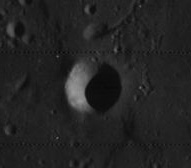 Lunar Orbiter 4 image | |
| Coordinates | 27°54′N47°30′W / 27.9°N 47.5°W |
|---|---|
| Diameter | 7 km |
| Depth | Unknown |
| Colongitude | 48° at sunrise |
| Eponym | Paolo Toscanelli |


Toscanelli is a tiny, bowl-shaped lunar impact crater that is located to the north of the prominent crater Aristarchus, in the northwestern part of the Moon. The crater lies at the southern end of a rille that proceeds towards the north. This rille is part of a nearby system that has the designation Rimae Aristarchus. Just to the south of Toscanelli is a fault line in the surface named the Rupes Toscanelli, after the crater. This break in the surface continues to the south for a distance of about 70 kilometers.